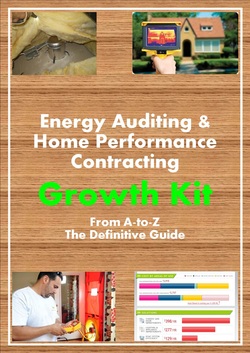Passing the BPI Exam With Energy Auditor Training
FREE BPI PRACTICE EXAMPUT YOUR HOME PERFORMANCE BUSINESS ON ROCKET FUELENERGY AUDITOR NEWSLETTERGet the only Energy Auditor Marketing Newsletter with monthly strategies and tactics to grow your home performance business.
The main topics of the BPI BA exam are listed out below. Click on a link that interests you, or you need some brushing up on to learn more on each subject.
1. Building Science Fundamentals 1a. Basic terms and definitions 1b. Principals of energy, air & moisture 1c. Combustion science 2. Buildings and Their Systems 2a. Building components 2b. Conservation strategies 2c. Comprehensive building assessment process 2d. Design considerations 3. Measurement and Verification of Building Performance 3a. Applied diagnostics and troubleshooting 4. BPI National Standards and Project Specifications 4a. Comprehensive building assessment 5. Analyzing Buildings Systems 5a. Comprehensive building assessment 5b. Appliances and lighting 6. Conduct and communications 6a. Conservation strategies |
BPI Written Exam - Section 2 Buildings and Their Systems
Water management is important to prevent mold and mildew growth. All water and moisture must be diverted away the home via several methods:
1. Drainage
During the BPI Field Exam, you should do a visual inspection around the perimeter of the house. One of the items you need to check for and mention to your BPI field proctor, is that you are looking for a slope the runs away from the home. This is to let stormwater, irrigation water, condensate water, water pumped from inside the house and any other source of moisture drain and go away from the house. If there is not a slope away from the house, moisture is likely to linger and can easily cause mold and mildew growth. If there is any neutral or ground that is sloped towards the home, we need to recommend fixing in our energy audit scope. 2. Plumbing Plumbing should also be sloped to allow for naturally drainage, be free of leaks or use a pump circulate the water out and away from the home. Plumbing leaks may be found with a thermal camera within walls or the floor. 3. Gutters Gutters and the roof slope should allow bulk water to drain away from the home. 4. Sump pumps Sump pumps should be used to pump water out and away from the home. They are used to remove water from condensate drains from the air handler unit in a basement and to overcome any positive elevation gain that natural drainage won't overcome. Next Section2a. Building Components
2b. Conservation Strategies
2c. Comprehensive Building Assessment Process
2d. Design considerations
|

